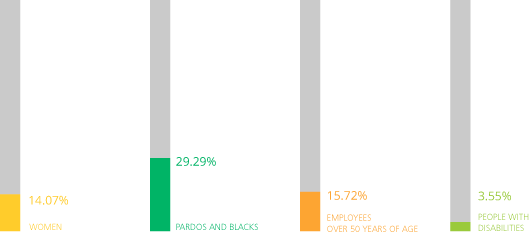Fibria's organizational development practices and policies are permeated by a culture of high performance, protagonism, and commitment of all employees. These characteristics are expected of the 17,701 own employees and contractors who are increasingly connected to the strategies of the business.
Our Human and Organizational Development actions seek to identify opportunities and influence organizational changes in people management. These actions are designed to enable high performance of individuals and teams by promoting self-development of people and supporting leadership in building a cause that inspires and engages employees.
Fibria prepares its professionals with a number of development programs, such as the program Primeira Liderança (First Leadership), while creating opportunities for professional growth within the company. One good example is the program Rotas de Desenvolvimento (Development Routes), which has already presented results in the forestry area and will soon be replicated in the industry.
People management also involves open dialogue about performance and potential, in annual assessment cycles geared toward employees at executive level and conducted by committees and direct managers.
In our daily lives, we also incorporate the i9 and i9 Focus programs, which recognize the protagonism of employees who contribute with innovative ideas, tackling the challenges and dilemmas of the company.

Photo: Márcio Schimming.
Outsourcing
Of Fibria's 17,000 employees, 76% are contractors and hired pursuant to labor legislation by companies that work mainly in the forestry operation, chosen by the company in rigorous selection processes.
Fibria believes that outsourcing - a global reality - is a good alternative when it does not represent precarious work and is consistent with the laws of the country. Therefore, we maintain ongoing dialogue with the legislative and executive powers of the government in order to share our opinion and experience.
Direct Jobs
| 2014 | 2015 | 2016 | |
|---|---|---|---|
| Own employees | 4,004 | 3,929 | 4,224 |
| Permanent contractors | 13,064 | 12,809 | 13,477 |
| Total | 17,068 | 16,738 | 17,701 |
Development Routes
Speaking of careers in a conventional way, as seen in the 1980s and 1990s, is a non-existent reality in a corporation today. Labor supply has changed over time. However, in increasingly more competitive markets, companies continue to require skilled labor and, thus, create opportunities for growth.
With this in mind, in 2015, Fibria implemented the program Rotas de Desenvolvimento na Área Florestal (Development Routes in Forestry), a program that maps critical positions in the area and selects employees with the potential to occupy them when there is a job opening. In general, they are difficult roles to be developed internally, such as supervisory positions, which require professionals better trained for decision making and relationships with various audiences. These professionals are selected by an internal committee and, as part of their current work routine, receive a development plan focused on projects and experiences related to future competencies.
With the same purpose, we are structuring the Development Routes in the Industrial Area. We are evaluating and adjusting the project to the specific needs of the mills, where changes in positions are always associated with deeper technical knowledge. We will make adaptations that favor an adequate and flexible succession environment.
First Leadership
Among the company's solid training programs, the First Leadership Program develops the company's first level leadership managers, formed by coordinators, supervisors, and technicians in management positions. It addresses the dilemmas of leadership in the daily lives of these professionals and helps them have better judgment skills for decision making. Difficulties faced by new leaders, a culture of feedback, influence and negotiation are also among the aspects covered. In the various phases of development and recycling, some 400 professionals have already attended the First Leadership program since its inception in 2013.
E-learning in the Industry
As complementary training and a way of disseminating organizational knowledge, we developed an e-learning program whose content was jointly created with executives from the industrial area, internally recognized as a reference. These professionals also acted as class instructors, increasing the connection of students with the proposal. The courses, which were provided to all employees of the mills, covered technical aspects of the production process and totaled 60 training hours.
TRAINING
| 2014 | 2015 | 2016 | |
|---|---|---|---|
| Resources invested in training and development (in BRL thousands) | 7,301 | 7,052 | 6,398 |
| Number of training hours | 223,483 | 197,031 | 142,560 |
| Total number of employees | 3,804 | 3,929 | 4,060 |
| Employees who received formal training in policies and procedures related to human rights issues and their applicability in the work of employees. | 1,861 | 1,440 | 863 |
| Total number of hours dedicated to training on policies and procedures associated with human rights aspects that are relevant to the operations | 7,501 | 25,082 | 5,008 |
i9 Program
An internal program on entrepreneurship and innovation, the i9 encourages our employees to suggest improvements to the business and to their own work routines.
It is us an opportunity to generate value in the company and to recognize and reward our professionals.
The ideas are recorded on our intranet (Fibria Net) and selected according to criteria such as customer value generation, increased productivity, increased revenue, cost reduction, environmental efficiency, and improvements in safety and health.
i9 Focus
This program is specifically geared toward the company's strategic needs year after year. Launched in 2015, under the energy efficiency aspect, it allowed for innovation to the boiler system in Jacareí, São Paulo.
Diversity
One of Fibria's goals in 2016 was to focus on diversity. We prepared a diagnostics study of all company practices: what they are, how they are communicated, and where opportunities can be found. We also conducted a diagnostics study about gender, issues on race, remuneration, sexual orientation, and disabilities, among other aspects. In possession of this map, we initiated a process to raise awareness of senior management regarding this aspect. The next step was to create an internal and multidisciplinary governance to address the subject.
In the process, we identified some internal practices that can be improved and others that should be better communicated, such as the possibility of including same-sex partners in employees' health insurance; among others. The study also pointed out that in the last three years the number of women in management positions has increased by 12%.

Succession
Fibria's Performance Management is an integrated and dynamic process in people management, and its objective is to stimulate individual, team, and organizational performance.
In annual cycles, a management committee evaluates executive-level professionals (consultants, coordinators, managers, and general managers), guided by the same vision on career development, performance, and beliefs. The committees' observations are used to support managers responsible for feedback. In 2016, the evaluation committee assessed 503 professionals (100% of the eligible audience).
In the following table, we present the percentage of employees who receive regular performance and career development appraisal, broken down by gender and employment category.
Performance Evaluation
| 2015 | 2016 | |||
|---|---|---|---|---|
| Category | Men | Women | Men | Women |
| Executives - General managers and managers | 100,0 | 100,0 | 100,0 | 100,0 |
| Supervisors/technicians | 100,0 | 100,0 | 100,0 | 100,0 |
| Operational1 | 27,0 | 74,0 | 73,0 | 65,0 |
| Management1 | 20,0 | 13,0 | 79,0 | 87,0 |
1 The evaluation cycle for the Administrative and Operational levels covers two years (January 2015 to December 2016). The tools are 100% available, although service is below 100% in some categories.
Proceeding with this work, we established a succession plan for all executive positions in the organization. The survey aims to identify which positions the professionals assessed by the Committee are likely to occupy, as well as identify their readiness to the position. With this, we hope to offer these professionals a clear route for development.
As part of the process, we evaluate possible movements within the company, succession availability in the market, and the risk of losing our potential talents.
For operational and administrative professionals (technicians, assistants, analysts), the assessment cycle formally takes place every two years, and is carried out between managers and their direct reports, and feedback should be given on strengths and areas for improvement after completion of the assessment of results and competencies, as well as alignment of the professional with the company's values and beliefs.
Breakdown of minority groups - 2016

Remuneration and Benefits
Fibria's salary and benefits structure reflects the standard used in the industry and in corporations whose remuneration programs are well regarded. We analyze the best practices of this select group of companies and every year we conduct studies that guarantee the competitiveness of our programs. As part of our annual cycle, salary readjustments and bonus recommendations are directly associated with employee performance and their contribution to company results.
Climate Survey
Held every two years, the Fibria Climate Survey had record number of participants in 2016: a total of 94% of respondents compared with 91% in the previous survey, which demonstrates a growth in the confidence level among company professionals.
In 2014, we began to use a methodology that evaluates the level of engagement of the professionals. Relying on engaged employees means having people working with a sense of 'ownership' and motivated to seek differentiated results.
The methodology used shows that 4.5 professionals are required to offset one actively non-engaged professional (4.5:1). From 2014 to date, there has been significant evolution: we jumped from 3.3:1 to 6.1:1 engagement ratio. The favorability rate has also grown over the last two years, from 72% to 79%.
Now, the process to disseminate and cascade the results across the organization begins, in addition to continuous management of the organizational climate, in which managers and teams must develop and follow plans focused on actions that impact company performance.
RETURN TO WORK AND RETENTION RATES AFTER MAT MATERNITY/PATERNITY, BROKEN DOWN BY GENDER1 GRI G4-LA3
| 2016 | |||
|---|---|---|---|
| Men² | Women | ||
| Number of employees who were entitled to maternity/paternity leave | 94 | 15 | |
| Number of employees who took maternity/paternity leave | 94 | 15 | |
| Number of employees returning to work upon termination of maternity/paternity leave | 94 | 15 | |
| Number of employees returning to work upon termination of maternity/paternity leave and who remained employed 12 months after their return to work | 94 | 15 | |
| Retention rate of employees returning to work upon termination of maternity/paternity leave | 100% | 100% | |
1 In 2013, the number of days women were entitled to maternity leave went from 120 to 180 days; 100% of the employees who were entitled to maternity/paternity leave enjoyed their leave.
2 in 2016, the number of days men were entitled to maternity leave went from 5 to 20 days.
